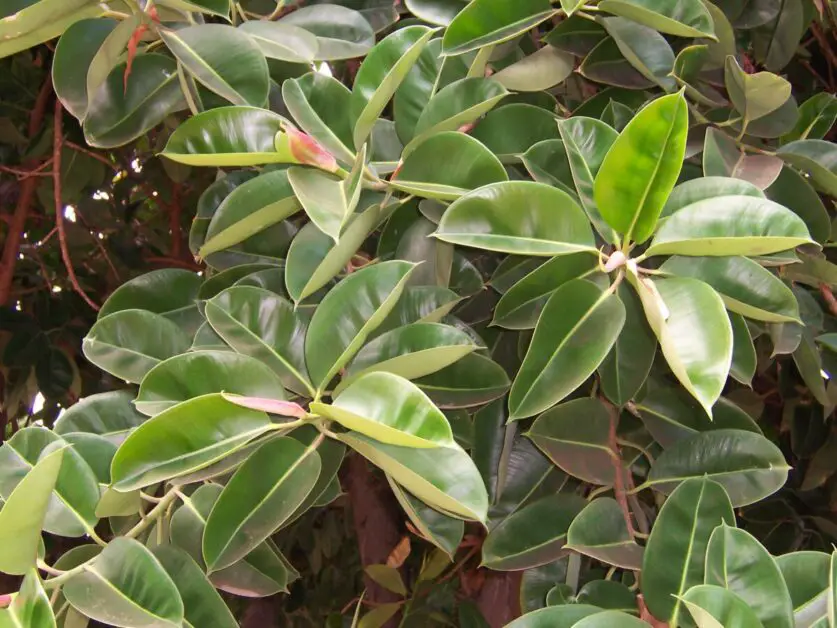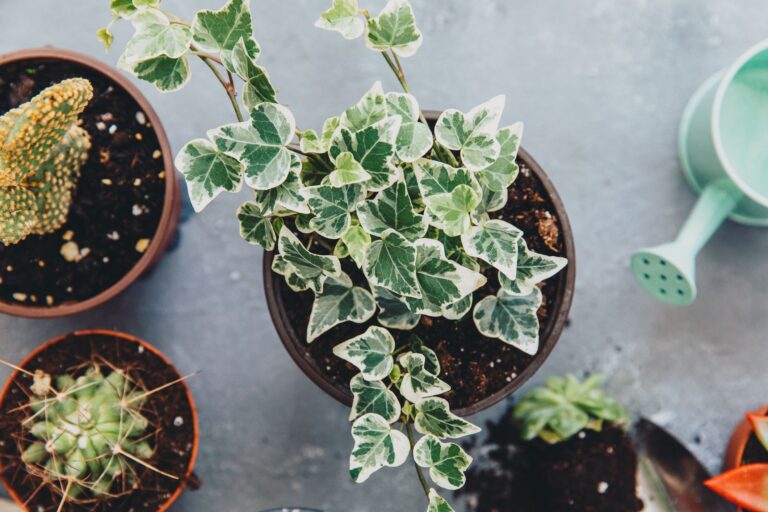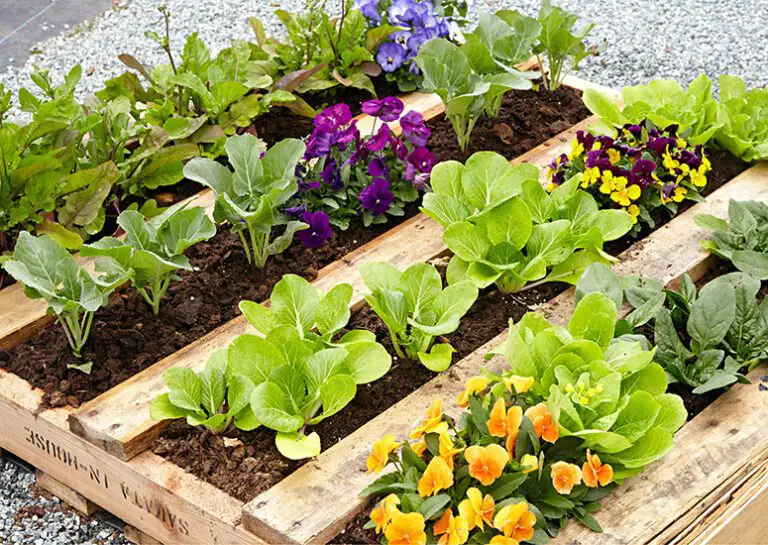Rubber Plant 101: How to Care for Ficus Elastica
Hey there, green thumbs and plant enthusiasts! Ever wondered how to keep your Rubber Plant, or Ficus Elastica, thriving and vibrant? Well, you’re in luck because we’ve got the ultimate guide for you.
Did you know that Rubber Plants are not only gorgeous additions to your indoor jungle but also natural air purifiers? Yup, they’re like little green superheroes, fighting off toxins and adding a touch of green elegance to your space.
In this comprehensive guide, we’ll walk you through everything you need to know to become a Rubber Plant pro. From watering tips to light requirements, we’ve got you covered. So, grab your gardening gloves and let’s dive in!
Table of Contents
Watering requirements for Ficus Elastica
Ficus Elastica, commonly known as the Rubber Plant, is a popular choice among plant enthusiasts due to its striking appearance and relatively low-maintenance nature. When it comes to watering this tropical plant, it is important to strike a balance to ensure its optimal growth and health.

- Monitor Soil Moisture: Check the soil moisture level regularly, as watering needs depend on factors like plant size, pot size, and environmental conditions.
- Allow Soil to Dry: To prevent issues like root rot, let the top layer of soil dry out between waterings, ensuring proper drainage.
- Avoid Overwatering: Overwatering can lead to root rot and fungal diseases, negatively impacting the health of your Rubber Plant.
- Prevent Underwatering: Insufficient watering can cause wilting leaves and overall plant distress, so maintain adequate moisture levels.
- Simple Test: Easily assess soil moisture by inserting your finger into the soil up to the second knuckle; if it feels dry at that depth, it’s time to water the plant.
However, it is essential to avoid letting the plant sit in standing water, as this can lead to root suffocation. By following these guidelines and observing your plant’s individual needs, you can ensure that your Ficus Elastica thrives and adds an elegant touch to your indoor space.
Lighting conditions for Rubber Plants
Rubber plants, scientifically known as Ficus elastica, are beautiful and versatile houseplants that can thrive in a variety of lighting conditions. However, providing the right amount of light is crucial to their overall health and growth.

- Light Conditions:
- Filtered, Indirect Sunlight:
- Rubber plants thrive in bright, indirect light.
- Place them near a window with filtered sunlight or in a well-lit room.
- Avoid direct sunlight, as it can scorch the leaves.
- Signs of Light Issues:
- Yellow or brown leaves indicate too much light exposure.
- Dark green, leggy growth suggests insufficient light.
- Filtered, Indirect Sunlight:
Remember to observe your rubber plant closely and adjust its placement based on its response to light. Happy gardening! 🌿🌱
Choosing the right pot for your Rubber Plant
Choosing the right pot for your Rubber Plant is essential for its overall health and growth. The size and material of the pot can greatly impact the plant’s well-being.

- Pot Size:
- Choose a pot appropriate for the current size of your Rubber Plant.
- If the pot is too small, roots may become cramped, leading to stunted growth and potential root rot.
- If the pot is too large, excess moisture can cause root rot.
- Aim for a pot about 2 inches larger in diameter than the plant’s root ball.
- Pot Material:
- Clay Pots:
- Provide good drainage and allow roots to breathe.
- Tend to dry out faster, so monitor watering needs accordingly.
- Plastic Pots:
- Retain moisture better but may limit airflow to the roots.
- Choose based on your watering habits and environmental conditions.
- Drainage Holes:
- Ensure the pot has drainage holes at the bottom to prevent water accumulation.
- Clay Pots:
By selecting the right pot size and material for your Rubber Plant, you can provide a conducive environment for its growth and ensure its long-term health. Remember, a well-designed pot can make a significant difference in the overall success of your indoor gardening endeavors.
Potting mix for Ficus Elastica
When it comes to potting mix for Ficus Elastica, it is essential to choose a well-draining medium that will provide the right balance of moisture and aeration for the plant’s roots.

- Optimal Potting Mix: Blend organic matter (such as peat moss or coconut coir) with inorganic material (perlite or vermiculite) for a balanced mix.
- Moisture Regulation: This combination retains adequate moisture while ensuring excess water drains away, preventing waterlogging.
- Drainage Improvement: Enhance drainage by incorporating a small amount of sand or fine gravel into the potting mix, crucial for preventing root rot and water-related problems in Rubber Plants.
- Slow-Release Fertilizer: Include a slow-release fertilizer in the mix to supply essential nutrients steadily over time, promoting healthy growth and foliage for your Ficus Elastica.
Remember, when repotting your Rubber Plant or planting it in a new container, always choose a potting mix that suits its specific needs. Avoid using heavy, compacted soils that can suffocate the roots and impede their growth. Instead, opt for a well-draining mix that promotes healthy root development and overall plant vitality.
Optimal temperature and humidity levels for Rubber Plants
Rubber plants, scientifically known as Ficus Elastica, thrive in specific temperature and humidity conditions. Providing the optimal environment for these plants is crucial in order to ensure their health and vitality.
- Temperature Preference: Rubber plants thrive in temperatures between 60°F and 75°F (15°C to 24°C), ideally suited for indoor settings.
- Avoid Extreme Conditions: Protect your plant from extreme temperature fluctuations or drafts, as these can cause stress and damage.
- Optimal Humidity: Maintain moderate humidity levels between 40% and 60%, replicating their native tropical habitat.
- Combat Dry Air: During dry periods, especially in winter with indoor heating, increase humidity around the plant using methods like humidifiers, water trays, or misting leaves.
By maintaining the optimal temperature and humidity levels, you can create a comfortable and suitable environment for your rubber plant to thrive.
The importance of proper drainage for your Rubber Plant
Proper drainage is an essential factor in maintaining the health and vitality of your Rubber Plant (Ficus Elastica).
- Choose the Right Pot: Opt for a pot with drainage holes at the bottom. This allows excess water to escape, preventing waterlogging. A pot made of terracotta or other breathable materials is ideal.
- Select a Well-Draining Potting Mix:
- Mix equal parts of peat moss, perlite, and sand to create a well-draining potting mix.
- Peat moss retains moisture while allowing air circulation.
- Perlite provides aeration and prevents compaction.
- Sand further enhances drainage.
- Layer the Pot:
- Place a layer of small stones or broken pottery shards at the bottom of the pot. This acts as a barrier, preventing soil from blocking the drainage holes.
- Add the potting mix on top of the layer.
- Water Wisely:
- Water your Rubber Plant thoroughly but allow excess water to drain out completely.
- Empty the saucer under the pot to prevent water accumulation.
- Monitor Moisture Levels:
- Check the soil moisture regularly by inserting your finger about an inch deep into the soil.
- Water only when the top inch of soil feels dry.
- Avoid Overwatering:
- Rubber Plants prefer slightly dry conditions over consistently wet soil.
- Adjust watering frequency based on the season and environmental conditions.
Remember, a well-draining environment will help your Rubber Plant thrive and prevent issues like root rot. Happy gardening! 🌿🌱
Fertilizing schedule for Ficus Elastica
Ficus Elastica, commonly known as the Rubber Plant, is a popular choice for indoor gardening enthusiasts due to its stunning foliage and ease of care. To ensure its health and vitality, a proper fertilizing schedule is essential.

- Fertilizing Frequency: Apply fertilizer every 2-3 months during the growing season (spring and summer) to support healthy foliage and overall growth.
- Choose Balanced Fertilizer: Opt for a water-soluble fertilizer specifically designed for indoor plants, with a balanced nitrogen, phosphorus, and potassium (NPK) ratio of 3:1:2 or 2:1:2.
- Dilution and Application: Dilute fertilizer to half strength and water thoroughly, ensuring soil absorption without overloading the roots.
- Avoid Dry Soil Application: Never apply fertilizer to dry soil, as it can scorch the roots; instead, water the plant beforehand to prevent damage.
- Monitor Growth Response: Adjust fertilization frequency and strength based on the plant’s reaction, avoiding overfertilization to prevent nutrient burn and leggy growth.
By following a regular fertilizing schedule and providing the necessary nutrients, your Ficus Elastica will thrive and continue to beautify your indoor space with its lush green leaves. However, remember that each plant is unique, so monitor its growth and adjust the fertilization regime accordingly.
Common pests and diseases that affect Rubber Plants
Rubber Plants, also known as Ficus Elastica, are generally hardy and resistant to pests and diseases. However, like any plant, they can still be susceptible to certain issues.
| Issue | Symptoms | Treatment | Effect on Plant |
|---|---|---|---|
| Common Pests | |||
| Aphids | – Tiny, soft-bodied insects under new leaves and buds- Yellow or brown leaves-Curled leaves | – Remove aphids manually- Use insecticidal soap | Reduced growth and vigor |
| Mealybugs | – White, cottony masses on leaves and stems- Yellowing and leaf drop | – Wipe off mealybugs with a damp cloth- Apply neem oil | Weakened plant health |
| Red Spider Mites | – Fine webbing on leaves- Yellow stippling and leaf discoloration | – Increase humidity- Spray with water- Use insecticidal soap | Leaves become pale and unhealthy |
| Scale Pests | – Small, immobile brown or black bumps on leaves and stems | – Remove scales manually- Apply horticultural oil | Reduced photosynthesis and stunted growth |
| Whiteflies | – Tiny white insects flying around the plant- Yellow, sticky leaves | – Use yellow sticky traps- Apply neem oil | Weakened plant due to sap loss |
| Common Diseases | |||
| Leaf Spot Diseases | – Circular brown spots on leaves- Yellow halos (sometimes) | – Remove affected leaves- Improve air circulation | Aesthetic damage but rarely fatal |
| Powdery Mildew | – White powdery patches on leaves | – Apply fungicides- Use neem oil | Reduced photosynthesis and growth |
| Root Rot Disease | – Yellowing leaves- Wilting- Root decay | – Improve drainage- Avoid overwatering | Severe root damage and plant death |
| Anthracnose | – Dark, sunken lesions on leaves and stems | – Prune affected parts- Apply fungicides | Reduced vigor and defoliation |
| Crown Gall | – Swollen, tumor-like growths on stems | – Remove affected areas- Disinfect tools | Impaired nutrient transport |
While Rubber Plants are generally low-maintenance and resilient, it is still important to monitor them closely for any signs of pests or diseases. By promptly addressing any issues that arise and providing the appropriate care, you can ensure the health and vitality of your Rubber Plant.
Pruning and shaping your Ficus Elastica
Pruning and shaping your Ficus Elastica is an important aspect of its care, as it helps maintain the desired size and shape of the plant. Regular pruning promotes bushier growth and keeps the plant looking attractive and well-maintained.
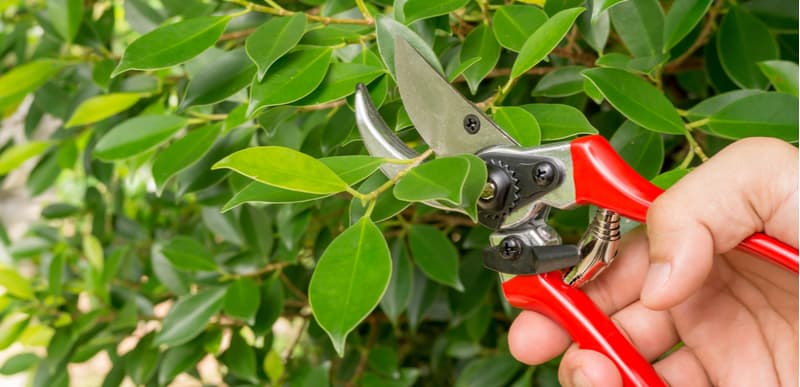
Propagating Rubber Plants: A step-by-step guide
Rubber plants, scientifically known as Ficus elastica, are popular houseplants due to their attractive leaves and low maintenance requirements. If you’re looking to expand your indoor garden or share the beauty of these plants with others, propagating rubber plants can be a rewarding and budget-friendly option. In this step-by-step guide, we will explore the process of propagating rubber plants, allowing you to create new plants from existing ones.
Step 1: Select a healthy and mature rubber plant from which to take cuttings. Look for a plant that is free from diseases, pests, and physical damage. It’s essential to have a sturdy and well-established parent plant to ensure successful propagation.
Step 2: Choose a suitable cutting for propagation. Look for a stem that is at least 6 inches long and has three to five healthy leaves. Make sure the cutting is free from any blooms or buds, as these can divert energy away from root development. Using a clean and sharp pair of scissors or pruning shears, cut the stem just below a leaf node, which is where the leaf connects to the stem.
Tips for repotting your Ficus Elastica
When it comes to repotting your Ficus Elastica, there are a few important tips to keep in mind. First and foremost, choose a pot that is slightly larger than the current one to provide room for growth. This will ensure that the roots have enough space to spread out and thrive.

- Prepare New Pot: Add a layer of drainage material (e.g., small rocks or broken pottery) at the bottom of the new pot to prevent water accumulation and root rot.
- Gentle Repotting: Carefully remove the plant from its current pot, avoiding root damage. Loosen soil and gently lift the plant, separating crowded or tangled roots for healthy growth.
- Choose Well-Draining Mix: Fill the new pot with a well-draining potting mix designed for indoor plants, ensuring the right balance of nutrients and moisture retention.
- Fill Gaps: Fill any gaps around the plant with fresh potting mix, providing support and stability for the Ficus Elastica.
- Thorough Watering: After repotting, give the plant a thorough watering to settle the soil and hydrate the roots.
- Optimal Light Conditions: Place the repotted plant in a location with bright, indirect light, avoiding direct sunlight to prevent leaf scorching.
By following these tips, you can ensure that your Ficus Elastica has a successful transition to its new pot, promoting healthy growth and longevity.
Creating a suitable indoor environment for your Rubber Plant
Creating a suitable indoor environment for your Rubber Plant is crucial for its growth and overall health. Rubber Plants thrive in bright, indirect light, so it is essential to place them near a window where they can receive ample sunlight. However, direct sunlight can scorch the leaves, so it is advisable to use sheer curtains or blinds to filter the light if necessary.
:max_bytes(150000):strip_icc()/grow-rubber-plant-ficus-indoors-1902755-02-700e0cea38e14a8987348973fb193f29.jpg)
- Temperature Range:
- Ideal Temperature: Aim for a temperature range of 60 to 75 degrees Fahrenheit (15 to 24 degrees Celsius).
- Avoid Cold Drafts: Rubber Plants are sensitive to cold drafts. Keep them away from windows or doors where chilly air might affect them.
- Stable Environment: Sudden temperature fluctuations can harm their growth, so maintain a stable environment.
- Relative Humidity:
- Target Humidity: Aim for a relative humidity level of around 50%.
- Misting: Regularly mist the leaves with water to increase humidity.
- Humidifier: Consider using a humidifier, especially during dry seasons or in centrally heated rooms.
By providing the right amount of light, temperature, and humidity, you can create an indoor environment that supports the growth and vitality of your Rubber Plant.
Troubleshooting common issues with Ficus Elastica
| Troubleshooting Ficus Elastica Issues | Common Issues and Solutions |
|---|---|
| 1. Yellowing Leaves | – Overwatering: Adjust watering frequency; allow soil to dry between waterings. |
| – Low Light: Ensure the plant receives adequate indirect sunlight. | |
| 2. Leaf Drop | – Sudden Changes: Gradually acclimate the plant to new light or temperature conditions. |
| – Watering Issues: Check soil moisture and adjust watering as needed. | |
| 3. Brown Tips or Edges | – Low Humidity: Increase humidity around the plant, especially in dry indoor environments. |
| – Water Quality: Use distilled or filtered water to avoid mineral build-up. | |
| 4. Pests (e.g., Spider Mites) | – Regular Inspection: Inspect the plant regularly for pests on leaves and stems. |
| – Natural Predators: Introduce beneficial insects or use neem oil for control. | |
| 5. Wilting | – Underwatering: Ensure consistent watering; adjust frequency based on soil moisture. |
| – Root Issues: Check for root rot; repot if necessary with well-draining soil. | |
| 6. Yellow Spots or Streaks | – Sunburn: Protect from direct sunlight, especially during intense midday hours. |
| – Nutrient Deficiency: Provide a balanced fertilizer; adjust based on plant needs. | |
| 7. Leggy Growth | – Pruning: Pinch back the tips regularly to encourage a bushier growth habit. |
| – Adequate Light: Ensure the plant receives sufficient indirect light for compact growth. | |
| 8. Soil Issues | – Well-Draining Mix: Use a well-draining potting mix to prevent waterlogging. |
| – Repotting: Repot if the soil becomes compacted or if the plant outgrows its container. |
Adding a balanced fertilizer with a nitrogen, phosphorus, and potassium (NPK) ratio specifically formulated for indoor plants can provide the necessary nutrients for the Rubber Plant’s growth and development. Remember to follow the manufacturer’s instructions and not to exceed the recommended dosage, as excessive fertilizer can cause leaf burn and other adverse effects.
Decorative uses for Rubber Plants in interior design
Rubber Plants, also known as Ficus Elastica, are not only beautiful additions to any indoor space, but they also offer a myriad of decorative uses in interior design. With their glossy, dark green leaves and striking aerial roots, Rubber Plants can instantly elevate the visual appeal of a room. These versatile plants can be used in various design styles, from modern to traditional, adding a touch of natural elegance.
:max_bytes(150000):strip_icc()/grow-rubber-plant-ficus-indoors-1902755--01-01-196969b3635e435b9d3b623d3d5a732f.jpg)
- Statement Piece: Rubber Plants serve as striking statement pieces due to their large, broad leaves and statuesque growth, ideal for filling empty corners or creating focal points in rooms.
- Height and Drama: Placing a tall Rubber Plant in an ornate decorative pot instantly adds height and drama to a space, drawing the eye upwards and creating a sense of grandeur.
- Tropical Ambiance: These plants contribute to a lush, tropical ambiance indoors, with their abundant greenery transforming sterile or minimalistic spaces into vibrant oases.
- Versatile Placement: Rubber Plants can be placed on side tables, bookshelves, or suspended from the ceiling in hanging planters, offering versatility in interior design.
- Natural Serenity: Incorporating Rubber Plants into interior decor brings a touch of nature indoors, fostering a calming and soothing atmosphere.
- Enhancing Aesthetics: Strategically placing Rubber Plants as statement pieces or to create a tropical vibe enhances the aesthetics of living spaces, adding beauty, texture, and a sense of natural serenity.
Benefits of having a Rubber Plant in your home or office
Rubber Plants, scientifically known as Ficus Elastica, offer a myriad of benefits when kept in your home or office. Besides their striking appearance, these plants contribute to a healthier and more stylish indoor environment.
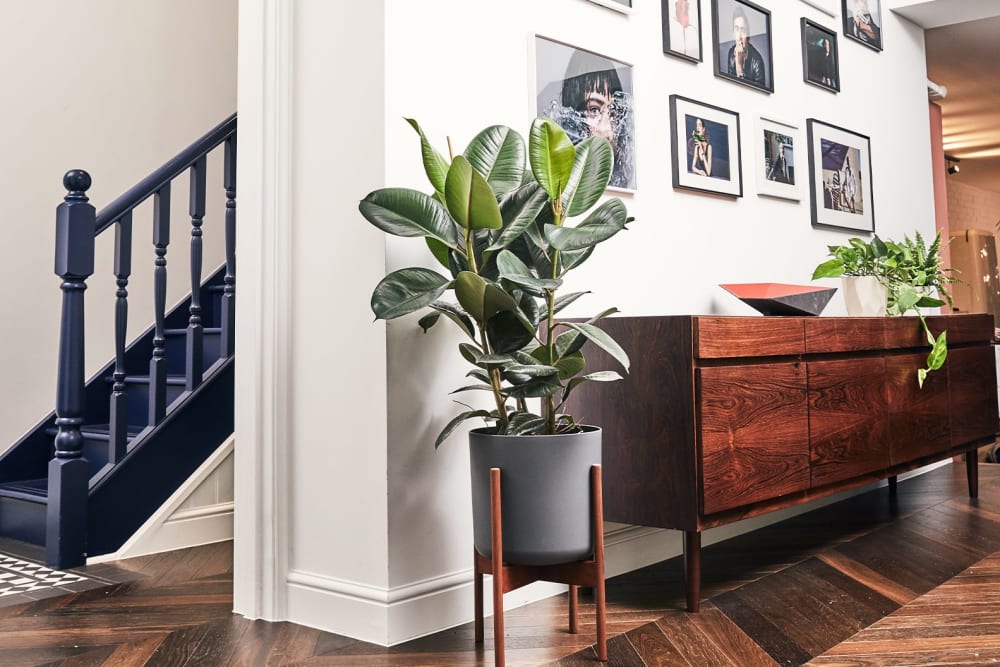
Rubber Plants are proficient at removing harmful toxins such as formaldehyde, benzene, and carbon monoxide from the air.
A NASA study found that Rubber Plants can eliminate up to 90% of formaldehyde present indoors.
Improved air quality reduces the risk of respiratory problems and promotes a healthier environment.
Numerous studies suggest that indoor plants positively impact mental health.
Having a Rubber Plant can reduce stress levels and promote relaxation.
The lush foliage creates a calming effect, enhancing overall well-being.
The vibrant green leaves of Ficus Elastica add visual interest to any space.
Whether placed in a living room, bedroom, or office, Rubber Plants elevate the ambiance.
They provide a refreshing and inviting atmosphere, making the environment more pleasant.
In conclusion, the benefits of having a Rubber Plant in your home or office extend beyond their aesthetic appeal. With their air-purifying qualities and their ability to promote mental well-being, these plants serve as valuable additions to any indoor environment. By introducing a Rubber Plant into your space, you not only enhance the aesthetics, but also contribute to a healthier and more harmonious atmosphere.
Watch video for more information:
FAQ
How often should I water my Rubber Plant?
The watering requirements for a Rubber Plant, also known as Ficus Elastica, depend on various factors such as the size of the plant, the pot it is planted in, and the environmental conditions. In general, it is recommended to water your Rubber Plant thoroughly when the top inch of soil feels dry. Avoid overwatering, as it can lead to root rot.
What lighting conditions are best for a Rubber Plant?
Rubber Plants thrive in bright, indirect light. They can tolerate some shade but will have slower growth in low light conditions. Avoid placing them in direct sunlight as it can scorch the leaves.
What type of pot is suitable for a Rubber Plant?
When choosing a pot for your Rubber Plant, opt for one with drainage holes at the bottom to prevent waterlogging. This will help maintain proper moisture levels in the soil and avoid root rot. Additionally, make sure the pot is sturdy enough to support the plant’s growth.
What kind of potting mix should I use for my Rubber Plant?
A well-draining potting mix is essential for Rubber Plants. You can use a combination of peat moss, perlite, and sand to create a suitable mix. This will ensure proper drainage and aeration for the plant’s roots.
What are the optimal temperature and humidity levels for Rubber Plants?
Rubber Plants prefer average room temperatures between 60-75°F (15-24°C). They can tolerate slightly lower temperatures but are sensitive to cold drafts. It is recommended to maintain moderate humidity levels around the plant, ideally between 40-60%.
How important is proper drainage for my Rubber Plant?
Proper drainage is crucial for the health of your Rubber Plant. It helps prevent waterlogging, which can lead to root rot. Ensure that your pot has drainage holes and use a well-draining potting mix to maintain optimal moisture levels.
How often should I fertilize my Rubber Plant?
Fertilize your Rubber Plant once every month during the growing season, which is spring and summer. Use a balanced liquid fertilizer diluted to half strength. Avoid fertilizing during the dormant period in fall and winter.
What are some common pests and diseases that affect Rubber Plants?
Rubber Plants can be susceptible to pests such as mealybugs, spider mites, and scale insects. Common diseases include leaf spot and root rot. Regularly inspect your plant for any signs of infestation or disease and take appropriate measures such as using insecticidal soap or adjusting watering practices.
How should I prune and shape my Rubber Plant?
Pruning and shaping your Rubber Plant can help maintain its desired size and shape. To prune, use clean and sharp pruning shears to remove any dead, damaged, or overgrown branches. You can also pinch back new growth to encourage bushier growth.
Can I propagate my Rubber Plant? If so, how?
Yes, Rubber Plants can be propagated through stem cuttings. Take a stem cutting with at least two nodes and remove the lower leaves. Place the cutting in a glass of water or a well-draining potting mix and keep it in a warm and bright location. Roots should develop within a few weeks.
When should I consider repotting my Rubber Plant?
Repot your Rubber Plant when it becomes root-bound, meaning the roots have filled the current pot and start to grow out of the drainage holes. This is usually done every 1-2 years. Choose a slightly larger pot with good drainage to accommodate the plant’s growth.
How can I create a suitable indoor environment for my Rubber Plant?
To create an ideal environment for your Rubber Plant, place it in a well-lit area with bright, indirect light. Maintain a temperature range of 60-75°F (15-24°C) and moderate humidity levels. Avoid placing it near cold drafts or in direct sunlight.
What are some troubleshooting tips for common issues with Rubber Plants?
If your Rubber Plant’s leaves are turning yellow, it could be a sign of overwatering or underwatering. Adjust your watering practices accordingly. If the leaves are dropping, it might indicate low humidity or insufficient light. Increasing humidity or adjusting the plant’s location can help.
How can I incorporate Rubber Plants into interior design?
Rubber Plants can add a touch of greenery and natural beauty to any indoor space. Their large, glossy leaves make them a visually appealing choice for decorating living rooms, offices, or other areas. They can be placed in decorative pots, used as focal points, or incorporated into a larger indoor plant arrangement.
What are the benefits of having a Rubber Plant in my home or office?
Rubber Plants offer various benefits, including improving indoor air quality by filtering toxins and releasing oxygen. They can also enhance the overall aesthetic of the space, reduce stress, and increase productivity. Additionally, they require minimal maintenance and are relatively easy to care for.

Studied Agricultural Engineering-Plant Protection at University of California, Davis.
Head of Content writing team at Southelmontehydroponics.com

